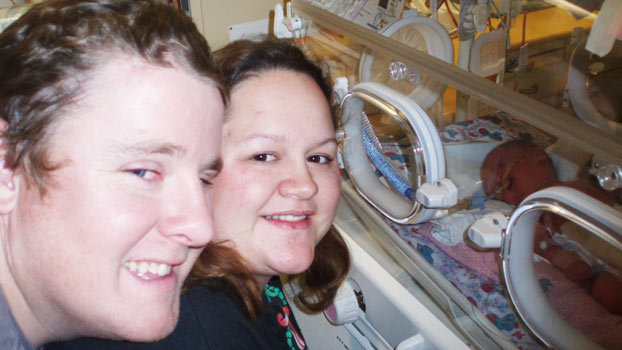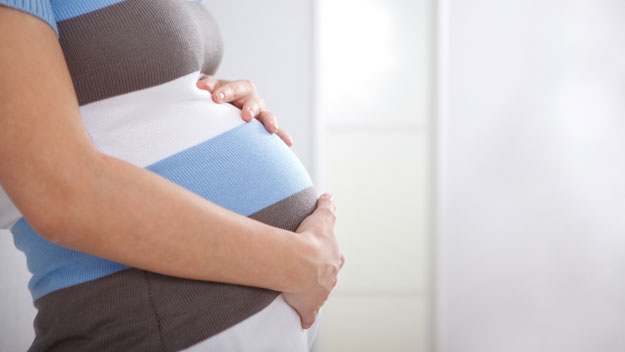I was 29 weeks pregnant when my waters broke. We were coming home from a friend’s birthday party when I felt a big gush, as if I’d just wet myself. I looked up at my partner, Ged, and said, “I think my waters just broke!” He said, ‘You’re only 29 weeks pregnant, this can’t be happening!’ But I knew it was. I was already having contractions so I asked Ged to call the hospital while I called my mum, crying hysterically.
Two days earlier I’d been diagnosed with gestational diabetes. After having my 28 weeks diabetes test my results came back extremely high. I was placed on a high dose of insulin three times a day. The last thing I expected to happen next was to go into labour the next day.
After the initital shock we made it to the hospital in record time. I waddled into the emergency department – my waters still dripping – and was rushed through to the birthing ward.
Here I was given a variety of shots to try to slow the labour down, as well as help mature my baby’s lungs and prepare her for birth if the labour couldn’t be stopped.
I was having regular, mild contractions and I was already 4cm dilated. The midwives decided to send me to a bigger hospital as they knew our baby was coming whether we wanted her to or not.
When I arrived at the new hospital I was strapped to a machine to monitor the baby. Again I was given a variety of shots but by this stage I was 7cm dilated. I felt ready to have my baby to end the pain and panic.
Eleven hours after my waters broke I gave birth naturally to my premature little girl, Charlotte Rose. She weighed just 1.83kg (4 pounds), which was very big for her age. One of the midwives told me she was the biggest 29-week premature baby she had ever seen.
Charlotte was rushed to the Neonatal Intensive Care Unit (NICU) and I was given a chance to clean up, calm down and compose myself before I went after her.
When I saw her in the humidicrib in the NICU my heart sank and I cried. I’ve never felt so heartbroken in all my life. There was my first child strapped to every machine possible with so many tubes and wires coming out of her and I couldn’t do anything to help her.
She stayed in the NICU for two weeks before being transferred to a special care nursery.
Despite all the disadvantages of being born premature, Charlotte made leaps and bounds every day. She was only on a breathing ventilator for two days before being put on a CPAP machine, which only helped her to breathe if she needed it. She had jaundice for six days and was under the blue lights a lot.
I didn’t have my first hold until she was five days old; Ged didn’t get his first hold for seven days. I sat beside her humidicrib every day, talking and singing to her, stroking her hands and feet, bathing her with damp cotton balls, changing her nappies. I did anything I could do just to touch her and feel like a ‘real’ mother.
I really wanted to breastfeed but as she was too little and not able to cope I expressed milk every three hours. At one stage I was expressing 200ml at a time and Charlotte was only drinking 2ml per feed. We had to buy another freezer to store all the extra milk.
When she got older and stronger we did try breastfeeding but unfortunately it was too hard for her – and too scary for me – so she made her way through my frozen supply and 11 weeks later I put her on formula.
After 62 very long days in hospital I was finally able to take Charlotte home. It was the happiest and proudest moment of my life! I finally felt complete knowing I was taking my baby with me and no one was going to stop me.
Doctors were unable to tell me why I went into labour so early or why Charlotte was so big for her age. They think maybe the gestational diabetes played a role but I guess we will never know. I still think about it every day. Sometimes I even blame myself for what happened.
Charlotte is now nearly two years old and she is perfect and beautiful. She did have a major setback when she was six-months-old and was diagnosed with epilepsy.
I couldn’t help but think, “Not again! Can’t my little girl just have a break?” But thankfully we have her epilepsy under control with medication and her reviews are showing she may grow out of it, which is fantastic.
She also has some slight developmental delays due to being premature, but her doctors assure me it will right itself when she is older.
Despite everything, Charlotte is such a happy, beautiful child and is so full of life. I can’t wait to watch her keep growing.
Written by Courtney Day




